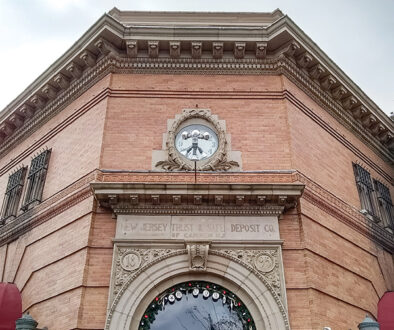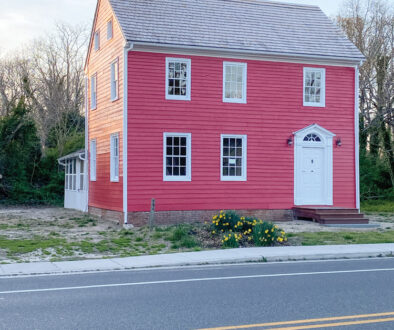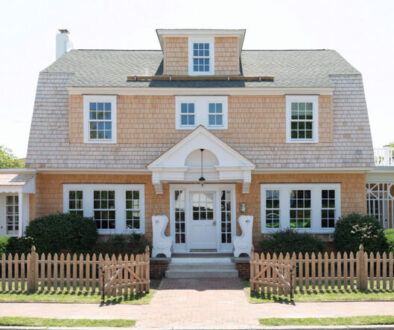Painting the Town

The term “painted ladies of Cape May” might seem like a dig at someone who overdid the eyeshadow, but it definitely isn’t off-color when it comes to describing the city’s Victorian homes. Painting the exterior of the home is more than just surface protection, more than presenting a fresh face to the community; it is a mix of history and artistry.
Randy Yarwasky, the owner of Red Apple Painting, is one of the painters tasked with keeping those ladies looking their best. Yarwaksy has worked on projects that range from whole home restoration to the repainting of a wrought-iron fence. At this writing, his crew was tackling a painting project of the exterior and interior of 402 Lincoln Avenue in Cape May Point. The home was built in 1876, and is now in the midst of a complete renovation. His goal is to restore the home to its original character. “Working on these historic properties is a lot like examining a time capsule,” said Yarwasky. “You can literally peel away layers on the wall and see each era. You see questionable color choices, cracks, stains and strange wallpaper, but it all tells the story of the home.”
The process starts with a thorough cleaning and scraping of the surfaces. “Often the homeowner has inherited over 100 years of problems, like rotting wood, which needs to be addressed properly before any paint is applied,” he added. Yarwasky estimated that it takes about three weeks to completely paint an interior of a place similar in size to the three-bedroom, two-bathroom Lincoln Avenue home. Painting the exterior takes approximately four weeks, with weather being a constant threat. Exteriors are cleaned, repairs are made as needed and then painted with a slow-drying oil-based primer that penetrates the wood.
When Yarwasky was a teenager, he learned the trade and painted houses with his father. Even after becoming a teacher of psychology for a number of years, Yarwasky never outgrew his love of painting.
“The skill needed to paint historic homes appealed to me,” he said, and noted that he would take the odd paint project throughout his teaching career. At age 50, Yarwasky decided to focus on historic home painting full time. He also enjoys teaching young painters the craft. “I show them the right way of doing things,” he said. “As a restoration painter, I’m fortunate enough to do the work that focuses on the right way to do things. Not just the fast and cheap way. When you work with these old homes, there is so much craftsmanship and detail that you don’t see much in new construction. There was an art to creating these homes, and there is an art to painting them.”
Before he picks up a paint brush, Yarwasky will investigate the background of a building and at times uncover the story of who originally called the place home. Despite working in a number of historic properties, Yarwasky ranks the Lincoln Avenue project as one of his career highlights. “A home tells the story of the people who live in them, and this one has such a rich history. It was the home of Dr. Fogg, a prominent person in Cape May at the time it was built. The current owners, Rob and Rebecca O’Shea, have fallen in love with the property and are planning on retiring here. They’ve really embraced the history behind the place and they want to do it justice,” he said. And, the exterior will be painted one of Yarwasky’s favorite choices for a historic home: white. Yarwasky said that people normally fall into one of three camps when it comes to picking an exterior color: historically accurate, historically appropriate, or those that go for the daring and/or dramatic.
At the Angel of the Sea, general manager Chester Sherel said maintaining the picture perfect pink paint with white trim is a continuous job, especially on such a large property. The Angel of Sea, on 5 Trenton Avenue, was built circa 1850 as a summer cottage for William Weightman Sr., a Philadelphia chemist. The Angel has been moved, cut in half and saved from demolition. “The house was repainted once during its restoration and again for its anniversary,” said Sherel. “But normally it is something that has to be done in phases. We can’t close off the entire inn to our guests at one time. Plus the best time of the year to paint is when it is the most crowded.” Sherel said that the Angel of the Sea has gone through a number of color schemes, including a minty green, as well as an all-white. While Sherel wasn’t positive why pink was chosen as the exterior color, he noted that it was a decision that has made the building stand out.
The over-the-top exterior color choices, such as teal, pink and lavender, aren’t what the Victorians would have painted their homes, according to Dr. George E. Thomas, historian and author of Cape May, Queen of the Seaside Resorts: Its History and Architecture. Thomas noted that before the Victorian era many hotels, homes and shops were painted a stark white, partly because white lead paint was thought to last longer than other colors, and that it gave a property a feeling of newness. With the rise of Victorian style architecture, the color movement started, which appealed to the romantic Victorian idea that fashion, architecture and furnishings should be beautiful rather than practical.
The Windward House, at 24 Jackson Street, features eye-catching teal green-colored shingles.
Owner Sandy Miller said the color was practically chosen for her. “When I bought the bought the house, it was covered with green asbestos siding. When those were removed, it had stained the original brown shingles a light green, so we went with the teal green color,” she explained. “I was okay with it because the house isn’t considered in the high Victorian era. But when it comes to other historic properties, I’m a purist, and I’d really like to see the historic colors represented.”
According to Thomas, from 1820 to 1920, there were six phases of style, marked by gradual shifts in the color palette. Colors in vogue during the Neo-Classical and early Victorian periods were light and delicate. Richer, deeper colors evolved during the high and late Victorian eras. The Edwardian period was characterized by an overall lightening of the palette. During the Colonial Revival period, colors became even lighter and cleaner. Victorian homes almost always had two color schemes, and the more dramatic homes would have three colors. The main body of the home would be a lighter color and the trim would be darker.
The Emlen Physick Estate, built in 1879 and home to Dr. Emlen Physick Jr., his widowed mother, Frances Ralston, and his maiden aunt Emilie Parmentier, is an example of a rich color scheme. The grounds of the Physick Estate are home to not only the Physick’s house, but also Hill House, and Carriage House, where the family’s horses and carriages, and later Dr. Physick’s Model T, were kept. The Mid-Atlantic Center for the Arts and Humanities, which restored and now maintains the property, had scientific paint analysis done on the Emlen Physick Estate at the time of the restoration to determine the original colors.
Welsh Color & Conservation, Inc., a company that also did analysis of the White House, Independence Hall and the Betsy Ross House, did microscopic paint and color analysis of the exterior of the Physick House by first scraping as many locations on the exterior as possible and then removing small samples for inspection under a microscope. Their analysis revealed a complex Victorian color scheme that used more than three different colors. A grayish reddish orange was used on the window sashes, and a light bluish gray and dark bluish gray were used on the body and trim.
The Queen Victoria, at 102 Ocean Street, was built in 1881 by Douglas Gregory, a Cape May native and Delaware River pilot, as a home for his family. A hundred years later, John Freeman, a color consultant at Sherwin Williams, was working on the American Century line of paint for the company’s Heritage Collection and was a frequent visitor at the inn. According to current owners Doug and Anna Marie McMain, the Queen Victoria had its paint peeled back in small sections to reveal its original green exterior. During the inn’s restoration it was painted Rookwood blue green with a Rookwood fence green trim. Sherwin Williams had offered the innkeepers a deal that if they featured the image of the Queen Anne on their Heritage Collection, the company would paint the inn for free. “The job was only supposed to take 50 gallons of paint,” said Doug McMain. “It ended up taking close to 90 gallons of paint.” McMain said that since the original restoration in the 1980s, he has had to repaint the side of the house that faces the beach twice. “The surfaces don’t weather at the same rate,” he said. “The north side of the house hasn’t been painted since the 80s. I’m going to try and get that done this spring.”
Keeping the historic properties looking good is a labor of love for painting contractor Rob Duzy. He said his firm, Core Painting & Powerwashing, was first hired in 2006 to restore the coatings on Congress Hall. At that time, he determined that there had been 45 percent paint loss on the brick exterior.
Because of the location near saltwater, along with National Park Service regulations against harsh chemicals, he used specialized fade-resistance masonry coating. Eight years later, Congress Hall was due for a repaint. The biggest need was to cover scuffmarks caused by hundreds of rocking chairs used by guests on the large veranda porches. The bright yellow color also needed a refresh.
Homes and hotels aren’t the only historic structures that need painting upkeep. MAC undertook two phases of the Cape May Lighthouse’s restoration in 1993-94 and is undertaking another paint restoration this year. “MAC is the steward of the Cape May Lighthouse, a beloved icon of the Cape May landscape and history, and works hard to maintain it. This repainting project is a very important part of the lighthouse’s ongoing maintenance. Once complete, the project will help to protect the Cape May Lighthouse from the harsh seaside elements and maintain it for visitors to continue to enjoy,” said MAC Executive Director Michael Zuckerman. Before paint is applied, the lighthouse will have to be pressure washed and any minor repairs of masonry or wood will have to be made. As for the iconic color scheme, it will have to be matched exactly, said MAC Communications Coordinator Susan Krysiak. The project will take two to three weeks to complete and is scheduled to start in October of this year.
The next time you are taking in the sights of some of your favorite Cape May places, keep in mind the small army of painters who keep them looking beautiful year after year.










